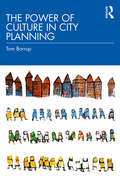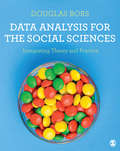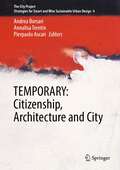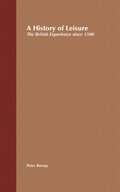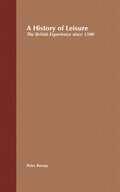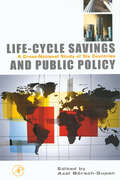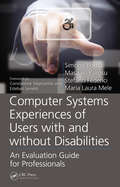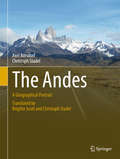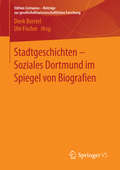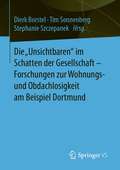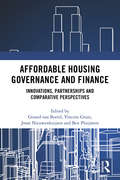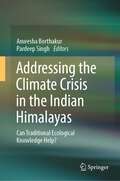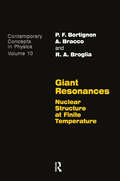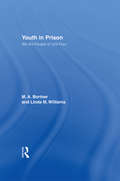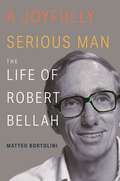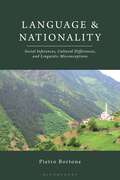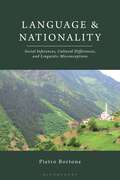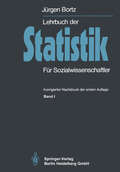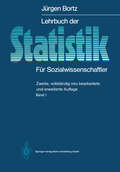- Table View
- List View
The Power of Culture in City Planning
by Tom BorrupThe Power of Culture in City Planning focuses on human diversity, strengths, needs, and ways of living together in geographic communities. The book turns attention to the anthropological definition of culture, encouraging planners in both urban and cultural planning to focus on characteristics of humanity in all their variety. It calls for a paradigm shift, re-positioning city planners’ "base maps" to start with a richer understanding of human cultures. Borrup argues for cultural master plans in parallel to transportation, housing, parks, and other specialized plans, while also changing the approach of city comprehensive planning to put people or "users" first rather than land "uses" as does the dominant practice. Cultural plans as currently conceived are not sufficient to help cities keep pace with dizzying impacts of globalization, immigration, and rapidly changing cultural interests. Cultural planners need to up their game, and enriching their own and city planners’ cultural competencies is only one step. Both planning practices have much to learn from one another and already overlap in more ways than most recognize. This book highlights some of the strengths of the lesser-known practice of cultural planning to help forge greater understanding and collaboration between the two practices, empowering city planners with new tools to bring about more equitable communities. This will be an important resource for students, teachers, and practitioners of city and cultural planning, as well as municipal policymakers of all stripes.
The Power of Culture in City Planning
by Tom BorrupThe Power of Culture in City Planning focuses on human diversity, strengths, needs, and ways of living together in geographic communities. The book turns attention to the anthropological definition of culture, encouraging planners in both urban and cultural planning to focus on characteristics of humanity in all their variety. It calls for a paradigm shift, re-positioning city planners’ "base maps" to start with a richer understanding of human cultures. Borrup argues for cultural master plans in parallel to transportation, housing, parks, and other specialized plans, while also changing the approach of city comprehensive planning to put people or "users" first rather than land "uses" as does the dominant practice. Cultural plans as currently conceived are not sufficient to help cities keep pace with dizzying impacts of globalization, immigration, and rapidly changing cultural interests. Cultural planners need to up their game, and enriching their own and city planners’ cultural competencies is only one step. Both planning practices have much to learn from one another and already overlap in more ways than most recognize. This book highlights some of the strengths of the lesser-known practice of cultural planning to help forge greater understanding and collaboration between the two practices, empowering city planners with new tools to bring about more equitable communities. This will be an important resource for students, teachers, and practitioners of city and cultural planning, as well as municipal policymakers of all stripes.
Data Analysis for the Social Sciences: Integrating Theory and Practice
by Professor Douglas Bors'This book fosters in-depth understanding of the logic underpinning the most common statistical tests within the behavioural sciences. By emphasising the shared ground between these tests, the author provides crucial scaffolding for students as they embark upon their research journey.' —Ruth Horry, Psychology, Swansea University 'This unique text presents the conceptual underpinnings of statistics as well as the computation and application of statistics to real-life situations--a combination rarely covered in one book. A must-have for students learning statistical techniques and a go-to handbook for experienced researchers.' —Barbra Teater, Social Work, College of Staten Island, City University of New York Accessible, engaging, and informative, this book will help any social science student approach statistics with confidence. With a well-paced and well-judged integrated approach rather than a simple linear trajectory, this book progresses at a realistic speed that matches the pace at which statistics novices actually learn. Packed with global, interdisciplinary examples that ground statistical theory and concepts in real-world situations, it shows students not only how to apply newfound knowledge using IBM SPSS Statistics, but also why they would want to. Spanning statistics basics like variables, constants, and sampling through to t-tests, multiple regression and factor analysis, it builds statistical literacy while also covering key research principles like research questions, error types and results reliability. It shows you how to: Describe data with graphs, tables, and numbers Calculate probability and value distributions Test a priori and post hoc hypotheses Conduct Chi-squared tests and observational studies Structure ANOVA, ANCOVA, and factorial designs Supported by lots of visuals and a website with interactive demonstrations, author video, and practice datasets, this book is the student-focused companion to support students through their statistics journeys.
Data Analysis for the Social Sciences: Integrating Theory and Practice
by Professor Douglas Bors'This book fosters in-depth understanding of the logic underpinning the most common statistical tests within the behavioural sciences. By emphasising the shared ground between these tests, the author provides crucial scaffolding for students as they embark upon their research journey.' —Ruth Horry, Psychology, Swansea University 'This unique text presents the conceptual underpinnings of statistics as well as the computation and application of statistics to real-life situations--a combination rarely covered in one book. A must-have for students learning statistical techniques and a go-to handbook for experienced researchers.' —Barbra Teater, Social Work, College of Staten Island, City University of New York Accessible, engaging, and informative, this book will help any social science student approach statistics with confidence. With a well-paced and well-judged integrated approach rather than a simple linear trajectory, this book progresses at a realistic speed that matches the pace at which statistics novices actually learn. Packed with global, interdisciplinary examples that ground statistical theory and concepts in real-world situations, it shows students not only how to apply newfound knowledge using IBM SPSS Statistics, but also why they would want to. Spanning statistics basics like variables, constants, and sampling through to t-tests, multiple regression and factor analysis, it builds statistical literacy while also covering key research principles like research questions, error types and results reliability. It shows you how to: Describe data with graphs, tables, and numbers Calculate probability and value distributions Test a priori and post hoc hypotheses Conduct Chi-squared tests and observational studies Structure ANOVA, ANCOVA, and factorial designs Supported by lots of visuals and a website with interactive demonstrations, author video, and practice datasets, this book is the student-focused companion to support students through their statistics journeys.
TEMPORARY: Citizenship, Architecture and City (The City Project #4)
by Andrea Borsari Annalisa Trentin Pierpaolo AscariThis book offers a comprehensive overview of forces shaping urban renewal and the sustainable and inclusive transformation of contemporary cities. It discusses temporariness and uncertainty of citizenship, participation, and inclusion, as well as the energy and digital transformation, merging different perspectives, such as the social, philosophical, economic, and architectural ones. Based on revised and extended contributions to the International Congress “TEMPORARY: Citizenship, Architecture and City", held virtually on November 20-21, 2022, from the University of Bologna, this book offers extensive information and a thought-provoking reading to researchers in architecture, anthropology, social and environmental policy, as well as to professionals and policy makers involved in planning the city of the future.
A History of Leisure: The British Experience since 1500
by Peter BorsayLeisure is a key aspect of modern living. How did our ancestors experience recreation in the past, and how does this relate to the present? To answer these questions, Peter Borsay examines the history of leisure in Britain over the past 500 years, analysing elements of both continuity and change. A History of Leisure- explores a range of pastimes, from festive culture and music to tourism and sport- emphasises a conceptual and critical approach, rather than a simple narrative history- covers a range of themes including economy, state, class, identities, place, space and time- treats the constituent parts of the British Isles as a fluid and dynamic amalgam of local and national cultures and polities.Authoritative and engaging, this text challenges conventional views on the history of leisure and suggests new approaches to the subject. Borsay draws upon the insights provided by a variety of disciplines alongside that of history - anthropology, the arts, geography and sociology - to offer an essential guide to this fascinating area of study.
A History of Leisure: The British Experience since 1500
by Peter BorsayLeisure is a key aspect of modern living. How did our ancestors experience recreation in the past, and how does this relate to the present? To answer these questions, Peter Borsay examines the history of leisure in Britain over the past 500 years, analysing elements of both continuity and change.A History of Leisure- Explores a range of pastimes, from festive culture and music to tourism and sport- Emphasises a conceptual and critical approach, rather than a simple narrative history- Covers a range of themes including economy, state, class, identities, place, space and time- Treats the constituent parts of the British Isles as a fluid and dynamic amalgam of local and national cultures and politiesAuthoritative and engaging, this text challenges conventional views on the history of leisure and suggests new approaches to the subject. Borsay draws upon the insights provided by a variety of disciplines alongside that of history - anthropology, the arts, geography and sociology - to offer an essential guide to this fascinating area of study.
Life-Cycle Savings and Public Policy: A Cross-National Study of Six Countries
by Axel Borsch-SupanLife-Cycle Savings and Public Policy examines data on many households from a number of different countries. The hope is that through these observations we can learn about the ways policies affect savings, and that other differences among savers can be controlled for, instead of being blamed on cultural differences. This book features a consistent framework among chapters. It reaches a harmony between measurement and analysis to compare accurately the resulting data and statistics. It provides econometric methodology to reveal the way policies affect savings. The book features data on household savings in Germany, Italy, Japan, the Netherlands, the U.K., and the U.S. This book is recommended reading for anyone interested in saving, social insurance policy, or capital formation. Features a consistent framework among chaptersReaches a harmony between measurement and analysis to compare accurately the resulting data and statisticsProvides econometric methodology to reveal the way policies affect savings
Computer Systems Experiences of Users with and Without Disabilities: An Evaluation Guide for Professionals
by Simone Borsci Masaaki Kurosu Stefano Federici Maria Laura MeleThis book provides the necessary tools for the evaluation of the interaction between the user who is disabled and the computer system that was designed to assist that person. The book creates an evaluation process that is able to assess the user's satisfaction with a developed system. Presenting a new theoretical perspective in the human computer i
The Andes: A Geographical Portrait (Springer Geography)
by Axel Borsdorf Christoph StadelThe Andes are attracting global interest again: they hold valuable mineral resources, tourists appreciate their great natural beauty and the diversity of indigenous cultures, climbers scale rock and ice faces, while many others are intrigued by regional political developments, such as the Bolivarian revolution in Venezuela or the almost unfettered hegemony of the neoliberal economic model in Chile.This volume is the first attempt for decades to present a complete overview of the longest mountain chain on the planet – a region of remarkable climatic, floristic and geologic diversity, where advanced civilization developed well before the arrival of the Spanish. Today the Andes continue to be characterized by their ethnic, demographic, cultural and economic diversity, as well as by the disparity of local socioeconomic groups. The Andean countries pursue a wide range of approaches to tackle the challenges of making the best use of their natural and cultural potential without damaging their ecological basis, as well as to overcome economic disparity and foster social cohesion. This book provides insights into this unique region and its most pressing issues, complemented by a wealth of pictures and comprehensive diagrams, which, in sum, help to better understand these fascinating mountains.
Stadtgeschichten - Soziales Dortmund im Spiegel von Biografien (Edition Centaurus – Jugend, Migration und Diversity)
by Dierk Borstel Ute FischerIm Zentrum des vorliegenden Bandes steht der soziale Wandel der Stadt Dortmund mit seinen zahlreichen Facetten. Was hält die Stadt in ihrem Innersten zusammen? Dieser Frage ging eine Seminargruppe der Fachhochschule Dortmund im Fachbereich der Angewandten Sozialwissenschaften nach. Das Buch berichtet neben harten Fakten über den sozialen Kern der Stadt entlang ausgewählter Biografien. Die Vielfalt von Sichtweisen, Interessen und Erfahrungen der Menschen, die in Dortmund leben, wird hier lebendig in den Fallgeschichten. Dabei offenbaren sich Ressourcen der Stadtgesellschaft, ebenso wie Herausforderungen, die angepackt werden müssen. Eindrucksvoll wird deutlich: Tatkraft ist vorhanden, sie braucht aber Gelegenheiten zum Gestalten.
Die „Unsichtbaren“ im Schatten der Gesellschaft - Forschungen zur Wohnungs- und Obdachlosigkeit am Beispiel Dortmund
by Dierk Borstel Tim Sonnenberg Stephanie SzczepanekObdachlosigkeit ist einer der schlimmsten persönlichen Schicksalsschläge in unserer Wohlstandsgesellschaft, und es gibt sie in jeder Stadt. Als Gegenstand sozialwissenschaftlicher Forschung ist Obdachlosigkeit aber dennoch unentdeckt. Die vorliegende Studie nähert sich dem Phänomen theoretisch wie empirisch.
Affordable Housing Governance and Finance: Innovations, partnerships and comparative perspectives
by Gerard Van BortelThere is a large shortage of affordable housing across Europe. In high‐demand urban areas housing shortages lead to unaffordable prices for many target groups. This book explores innovations to support a sufficient supply of affordable and sustainable rental housing. Affordable housing is increasingly developed, financed and managed by a mix of market, state, third sector and community actors. Recent decades in large parts of the Western world have consecutively shown state-dominated, non-profit housing sectors, an increased role for market forces and the private sector, and the rise of initiatives by citizens and local communities. The variety of hybrid governance and finance arrangements is predicted to increase further, leading to new affordable housing delivery and management models. This book explores these innovations, with a focus on developments across Europe, and comparative chapters from the USA and Australia. The book presents new thinking in collaborative housing, co-production and accompanying finance mechanisms in order to support the quantity and the quality of affordable rental housing. Combining academic robustness with practical relevance, chapters are written by renowned housing researchers in collaboration with practitioners from the housing sector. The book not only presents, compares and contrasts affordable housing solutions, but also explores the transferability of innovations to other countries. The book is essential reading for researchers and professionals in housing, social policy, urban planning and finance.
Affordable Housing Governance and Finance: Innovations, partnerships and comparative perspectives
by Gerard Van Bortel Vincent Gruis Joost Nieuwenhuijzen Ben PluijmersThere is a large shortage of affordable housing across Europe. In high‐demand urban areas housing shortages lead to unaffordable prices for many target groups. This book explores innovations to support a sufficient supply of affordable and sustainable rental housing. Affordable housing is increasingly developed, financed and managed by a mix of market, state, third sector and community actors. Recent decades in large parts of the Western world have consecutively shown state-dominated, non-profit housing sectors, an increased role for market forces and the private sector, and the rise of initiatives by citizens and local communities. The variety of hybrid governance and finance arrangements is predicted to increase further, leading to new affordable housing delivery and management models. This book explores these innovations, with a focus on developments across Europe, and comparative chapters from the USA and Australia. The book presents new thinking in collaborative housing, co-production and accompanying finance mechanisms in order to support the quantity and the quality of affordable rental housing. Combining academic robustness with practical relevance, chapters are written by renowned housing researchers in collaboration with practitioners from the housing sector. The book not only presents, compares and contrasts affordable housing solutions, but also explores the transferability of innovations to other countries. The book is essential reading for researchers and professionals in housing, social policy, urban planning and finance.
Addressing the Climate Crisis in the Indian Himalayas: Can Traditional Ecological Knowledge Help?
by Anwesha Borthakur Pardeep SinghThis book focuses on the traditional ecological knowledge in addressing the current climate crisis in the Indian Himalayas. Local or indigenous people in the Himalayas, through their low-carbon producing lifestyles, contribute very little to the climate crisis. However, at the same time, they bear the brunt of this crisis way more than many others. It is important to learn about their traditional ways of life and the knowledge that they hold regarding ecology and environment. Traditional ecological knowledge and associated belief systems are given increasing attention across the globe in recent times toward addressing some of the grave environmental concerns. Climate change is one such concern. The rising consideration of concepts such as ethnoecology and ethnobotany signifies the scientific, socio-cultural and economic potential of the traditional ecological knowledge systems. It is indisputable that these knowledge systems have the ability to provide important insights towards tackling many present-day environmental distresses including several climate change challenges. In this book, the authors concentrate on such traditional ecological knowledge systems in the Indian Himalayan region and try to figure out their significance in relation to the modern science. Overall, the authors attempt to write a book where the relevance of traditional ecological knowledge systems could be addressed and communicated to a larger audience—both academic scientific and non-academic.
Giant Resonances
by P.F. Bortigan A. Bracco R.A. BrogilaThe series of volumes, Contemporary Concepts in Physics, is addressed to the professional physicist and to the serious graduate student of physics. The subject of many-body systems constitutes a central chapter in the study of quantum mechanics, with applications ranging from elementary particle and condensed matter physics to the behaviour of compact stellar objects. Quantal size effects is one of the most fascinating facets of many-body physics; this is testified to by the developments taking place in the study of metallic clusters, fullerenes, nanophase materials, and atomic nuclei. This book is divided into two main parts: the study of giant resonances based on the atomic nucleus ground state (zero temperature), and the study of the y-decay of giant resonances from compound (finite temperature) nuclei.
Giant Resonances
by P.F. Bortigan A. Bracco R.A. BrogilaThe series of volumes, Contemporary Concepts in Physics, is addressed to the professional physicist and to the serious graduate student of physics. The subject of many-body systems constitutes a central chapter in the study of quantum mechanics, with applications ranging from elementary particle and condensed matter physics to the behaviour of compact stellar objects. Quantal size effects is one of the most fascinating facets of many-body physics; this is testified to by the developments taking place in the study of metallic clusters, fullerenes, nanophase materials, and atomic nuclei. This book is divided into two main parts: the study of giant resonances based on the atomic nucleus ground state (zero temperature), and the study of the y-decay of giant resonances from compound (finite temperature) nuclei.
Youth in Prison: We the People of Unit Four
by M. A. Bortner Linda WilliamsBased on two years of intensive research in a juvenile prison, this study tells the story of youths in a "model program," created after a class action lawsuit for inhumane and illegal practices. It captures their lives inside and outside of prison: from drugs, gangs and criminal behaviour to the realities of families, schools and neighbourhoods. Drawing on experience that encompasses 20 years of juvenile justice research and policy analysis, the authors scrutinize the prison's attempts to combine accountability and treatment for youths with protection for the public, situating these within the larger social and political context.
Youth in Prison: We the People of Unit Four
by M. A. Bortner Linda WilliamsBased on two years of intensive research in a juvenile prison, this study tells the story of youths in a "model program," created after a class action lawsuit for inhumane and illegal practices. It captures their lives inside and outside of prison: from drugs, gangs and criminal behaviour to the realities of families, schools and neighbourhoods. Drawing on experience that encompasses 20 years of juvenile justice research and policy analysis, the authors scrutinize the prison's attempts to combine accountability and treatment for youths with protection for the public, situating these within the larger social and political context.
A Joyfully Serious Man: The Life of Robert Bellah
by Matteo BortoliniThe brilliant but turbulent life of a public intellectual who transformed the social sciencesRobert Bellah (1927–2013) was one of the most influential social scientists of the twentieth century. Trained as a sociologist, he crossed disciplinary boundaries in pursuit of a greater comprehension of religion as both a cultural phenomenon and a way to fathom the depths of the human condition. A Joyfully Serious Man is the definitive biography of this towering figure in modern intellectual life, and a revelatory portrait of a man who led an adventurous yet turbulent life.Drawing on Bellah's personal papers as well as in-depth interviews with those who knew him, Matteo Bortolini tells the story of an extraordinary scholarly career and an eventful and tempestuous life. He describes Bellah's exile from the United States during the hysteria of the McCarthy years, his crushing personal tragedies, and his experiments with sexuality. Bellah understood religion as a mysterious human institution that brings together the scattered pieces of individual and collective experiences. Bortolini shows how Bellah championed intellectual openness and innovation through his relentless opposition to any notion of secularization as a decline of religion and his ideas about the enduring tensions between individualism and community in American society.Based on nearly two decades of research, A Joyfully Serious Man is a revelatory chronicle of a leading public intellectual who was both a transformative thinker and a restless, passionate seeker.
A Joyfully Serious Man: The Life of Robert Bellah
by Matteo BortoliniThe brilliant but turbulent life of a public intellectual who transformed the social sciencesRobert Bellah (1927–2013) was one of the most influential social scientists of the twentieth century. Trained as a sociologist, he crossed disciplinary boundaries in pursuit of a greater comprehension of religion as both a cultural phenomenon and a way to fathom the depths of the human condition. A Joyfully Serious Man is the definitive biography of this towering figure in modern intellectual life, and a revelatory portrait of a man who led an adventurous yet turbulent life.Drawing on Bellah's personal papers as well as in-depth interviews with those who knew him, Matteo Bortolini tells the story of an extraordinary scholarly career and an eventful and tempestuous life. He describes Bellah's exile from the United States during the hysteria of the McCarthy years, his crushing personal tragedies, and his experiments with sexuality. Bellah understood religion as a mysterious human institution that brings together the scattered pieces of individual and collective experiences. Bortolini shows how Bellah championed intellectual openness and innovation through his relentless opposition to any notion of secularization as a decline of religion and his ideas about the enduring tensions between individualism and community in American society.Based on nearly two decades of research, A Joyfully Serious Man is a revelatory chronicle of a leading public intellectual who was both a transformative thinker and a restless, passionate seeker.
Language and Nationality: Social Inferences, Cultural Differences, and Linguistic Misconceptions
by Pietro BortoneWhat role does language play in the formation and perpetuation of our ideas about nationality and other social categories? And what role does it play in the formation and perpetuation of nations themselves, and of other human groups? Language and Nationality considers these questions and examines the consequences of the notion that a language and a nationality are intrinsically connected. Pietro Bortone illustrates how our use of language reveals more about us than we think, is constantly judged, and marks group insiders and group outsiders. Casting doubt on several assumptions common among academics and non-academics alike, he highlights how languages significantly differ among themselves in structure, vocabulary, and social use, in ways that are often untranslatable and can imply a particular culture. Nevertheless, he argues, this does not warrant the way language has been used for promoting a national outlook and for teaching us to identify with a nation. Above all, the common belief that languages indicate nationalities reflects our intellectual and political history, and has had a tremendous social cost. Bortone elucidates how the development of standardized national languages – while having merits – has fostered an unrealistic image of nations and has created new social inequalities. He also shows how it has obscured the history of many languages, artificially altered their fundamental features, and distorted the public understanding of what a language is.
Language and Nationality: Social Inferences, Cultural Differences, and Linguistic Misconceptions
by Pietro BortoneWhat role does language play in the formation and perpetuation of our ideas about nationality and other social categories? And what role does it play in the formation and perpetuation of nations themselves, and of other human groups? Language and Nationality considers these questions and examines the consequences of the notion that a language and a nationality are intrinsically connected. Pietro Bortone illustrates how our use of language reveals more about us than we think, is constantly judged, and marks group insiders and group outsiders. Casting doubt on several assumptions common among academics and non-academics alike, he highlights how languages significantly differ among themselves in structure, vocabulary, and social use, in ways that are often untranslatable and can imply a particular culture. Nevertheless, he argues, this does not warrant the way language has been used for promoting a national outlook and for teaching us to identify with a nation. Above all, the common belief that languages indicate nationalities reflects our intellectual and political history, and has had a tremendous social cost. Bortone elucidates how the development of standardized national languages – while having merits – has fostered an unrealistic image of nations and has created new social inequalities. He also shows how it has obscured the history of many languages, artificially altered their fundamental features, and distorted the public understanding of what a language is.
Lehrbuch der Statistik: Für Sozialwissenschaftler
by J. BortzMit diesem Buch wird der Versuch unternommen, eine Reihe von statistischen Verfahren sowie deren Beziehungen untereinander und zu generellen sozialwissenschaftliehen Metho denproblemen zu behandeln, die gewöhnlich nicht in einem einzelnen Lehrbuch erörtert werden. Angesichts des weitgesteckten inhaltlichen Rahmens und einer Begrenzung des geplanten Buchumfanges mußten allerdings bezüglich der mathematischen Herleitung der Verfahren einige Abstriche gemacht werden. Mir kam es vor allem darauf an, dem Leser die interne Logik, die rechnerische Durchführung und den Stellenwert der behandelten statistischen Methoden im Rahmen empirischer Forschungen zu verdeutlichen, wobei ich hierbei den Vorwurf gelegentlicher Weitschweifigkeit gern in Kauf nehme. Obgleich es mein Bestreben war, die ftir dieses Buch relevante Literatur möglichst weitgehend zu berück sichtigen, bin ich mir sicher, daß der eine oder andere wichtige Beitrag übersehen wurde. Für diesbezügliche Anregungen sowie Hinweise auf Formel-und Rechenfehler, die vermut lich trotz mehrfachen Korrekturlesens nicht entdeckt wurden, bin ich dem Leser sehr dankbar. Das Buch ist aus Lehrveranstaltungen hervorgegangen, die ich seit mehreren Jahren im Fach "Psychologische Methodenlehre" am Institut ftir Psychologie der Technischen Uni versität Berlin durchführe. Es wendet sich dementsprechend an einen Leserkreis, dem in erster Linie Psychologiestudenten angehören. Da jedoch Verfahren behandelt werden, die generell einsetzbar sind, wenn es um die Auswertung empirischer Daten geht, kann dieses Buch auch dem Studenten der Soziologie, der Pädagogik, der Medizin, der Wirtschaftswis senschaften usw. Anregungen vermitteln. Besondere mathematische Vorkenntnisse, die über die übliche schulmathematische Vorbildung hinausgehen, sind zum Verständnis des Textes nicht erforderlich.
Lehrbuch der Statistik: Für Sozialwissenschaftler
by J. BortzDie korrekte Anwendung statistischer Verfahren setzt voraus, daß die Bedeutung der Statistik für empirisch-wissenschaftliches Arbeiten richtig eingeschätzt wird. In unserem Verständnis beschränkt sich Statistik nicht nur auf die Zusammenfassung und Darstellung von Daten (dies ist die Aufgabe der deskriptiven Statistik, die im ersten Kapitel behandelt wird), sondern sie ermöglicht allen empirischen Wissen schaften objektive Entscheidungen über die Brauchbarkeit der überprüften Hypothe sen. Dieser Teilaspekt der Statistik, der sich mit der Überprüfung von Hypothesen befaßt, wird häufig als analytische Statistik oder Inferenz-(schließende) Statistik bezeichnet. lnferenzstatistische Aussagen sind Wahrscheinlichkeitsaussagen über die Vereinbarkeif der in den Untersuchungsdaten erfaßten Realität mit den aus einer Theorie abgeleiteten Hypothesen. Betrachten wir als Hauptziel des wissenschaftlichen Arbeitens die Verdichtung von Einzelinformationen und Beobachtungen zu allgemein gültigen theoretischen Aussagen, leitet hierbei die deskriptive Statistik zu einer übersichtlichen und anschaulichen Informationsaufbereitung an, während die Inferenzstatistik eine Informationsbewertung im Lichte theoretischer Aussagen bzw. -wie es richtiger heißen muß - eine Überprüfung der theoretischen Aussagen angesichts der beobachteten Realität ermöglicht. Für den sinnvollen Einsatz der Statistik ist es deshalb erforderlich, daß ihr eine theoretisch begründete, konkrete Fragestellung vorgeordnet ist. Die Funktion der deskriptiven und der schließenden Statistik im Rahmen der empirischen Sozialwissenschaften sei an einem kleinen Beispiel verdeutlicht. Jemand interessiert sich für das Sprachverhalten von Kindern einer sozialen Schicht. Der deskriptiven Statistik entnehmen wir beispielsweise, wie auf Grund von Strichlisten für verschiedene Sprachmerkmale Häufigkeitsverteilungen erstellt bzw.
